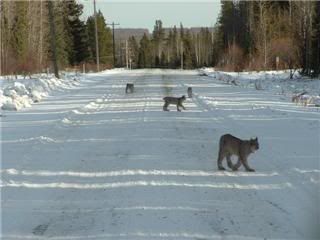
After a brief intermission, the Canada lynx issue is back to the forefront of outdoor politics in the state of Minnesota. This past Monday, a federal judged ruled that the Minnesota DNR “promptly take all action necessary to [ensure] no further taking of threatened Canada lynx”. Basically, this means that the state must apply for an “incidental take permit” (ITP) from the federal government, which would protect the state against any further lawsuits resulting from lynx killed as a result of state regulated trapping.
This new ruling comes at the heels of two recent federal lawsuits regarding the taking of lynx: one in Minnesota and one in Maine. Both lawsuits were filed by animal rights groups, and both were settled with the agreement that the respective states file for ITP’s with the feds. Minnesota reached their agreement with very little compromise in trapping regulations, while the Maine settlement resulted in some very significant changes in the way trappers were able to operate.
Now, just months later, the Center for Biological Diversity and the Animal Protection Agency are back in Minnesota and are demanding that additional regulations be placed on trappers to prevent the taking of lynx. A simple look into the history of actions by such groups indicates that they do not back down until they achieve their view of success.
The likely result of the new lawsuit is that Minnesota will have to significantly change their trapping regulations similar to the changes implemented by the Maine Department of Inland Fisheries and Wildlife. Temporary regulations that both sides can agree on will be put in place while the ITP is filed, and ITP regulations will be at least as strict, if not stricter than the temporary regulations. The ITP process is supposed to take about a year, but as we all know, dealing with the federal government almost always takes more time that expected.

This new lawsuit raises a number of questions that we, as concerned trappers, should be asking ourselves. For instance, do lawsuit settlements work, and should trappers compromise their rights? How far are these groups willing to go? Is their goal really to protect lynx, or will they continue to use the Endangered Species Act to further regulate trappers and hunters until these activities are all but eliminated?
A recent quote in the Duluth News Tribune may provide some of the answer to these questions:
“If they (DNR) can’t demonstrate another way to avoid trapping lynx, it could prohibit all trapping in the lynx range. We’d be very much in favor of that,’’ said Nicole Paquette, attorney for California-based Animal Protection Institute which filed the suit against the DNR.
I think it’s safe to say that the API and other groups are determined to eliminate trapping and will use all of the legal and financial resources available until they accomplish this goal. The lynx battle will not stop in Minnesota and Maine, either. Other states that have small lynx populations, like Utah, Montana and Idaho will likely be subject to future lawsuits to influence trapping and other outdoor activities. Maine and Minnesota were likely chosen to set a precedent for future lawsuits because they provide political environments that are less hostile toward animal rights groups and provided such groups with better chances for success.
Despite their relatively small numbers and meager financial resources, trappers and other hunting/fishing/outdoor groups are not backing down from these suits without a fight. Groups like the Minnesota Trappers Association, National Trappers Association, Fur Takers of America, Minnesota Outdoor Heritage Alliance and Safari Club International are all working to fight this battle to the best of their capacity.
There’s little question that the trappers and sportsmen have science on their side. Only a handful of Canada lynx, which are at the southern tip of their geographic range in Maine and Minnesota, have been killed in traps over the past few years, which pales in comparison to the number that die of natural causes, the greatest of which is usually starvation due to lack of food resources. If the number of lynx killed incidentally by trappers were significant, the states would undoubtedly implement their own measures to protect these lynx populations. A plethora of data collected over the years shows that factors influencing lynx numbers are independent of and not influenced by trapping activities. However, the Federal Endangered Species Act can sometimes trump sound science, and groups using the ESA to restrict the activities of others often know or care little about wildlife management and populations dynamics.
If you’re interested in supporting trapping and sporting groups in the fight against lawsuits like these, I would encourage you to join and become active in your local and national trapping associations and other groups that work to preserve this unique heritage while ensuring the long term viability and health of furbearer populations.
See a list of trapping organizations here.
See the news stories below:
Judge orders Minnesota DNR to reduce accidental lynx trappings
Question about the 2nd pic down. Is it your’s?
the reason I ask is because an anti used that very picture in one of the letters to the Feds as an argument to increase the land area. As I recall, the letter claims pictures were taken on a hike by them.
I’ve read so many of the commnets that they have become mixed together.
Regards bpb
Blackpowderbill,
The second pic down was taken near St. Leonard, New Brunswick on the Irving Woodlands Road, which is across the border from Van Buren, Maine. It isn’t my picture, but I can verify the location. Hope this helps clarify things.